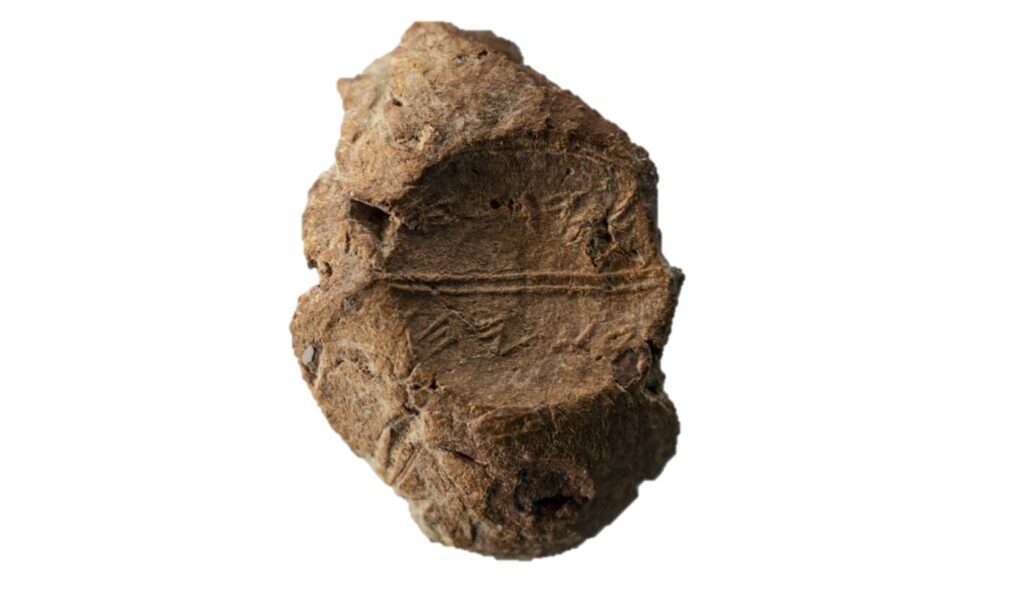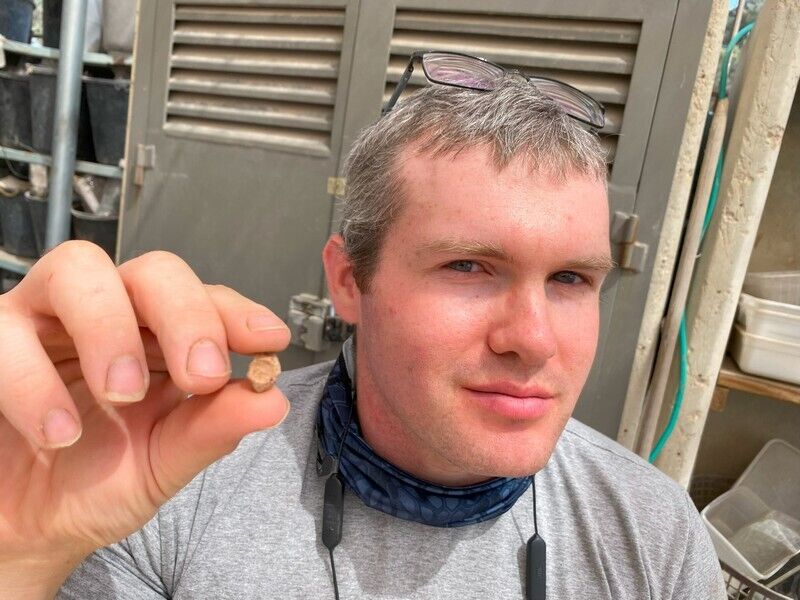In the shadow of the Temple Mount, where our ancestors once offered sacrifices and King David established the eternal capital of Israel, archaeologists have uncovered a remarkable piece of evidence that validates the historical accuracy of the Hebrew Bible. A tiny clay bulla (seal impression) has emerged from Temple Mount soil, bearing witness to the servants who faithfully administered the kingdom during one of Israel’s greatest periods of national renewal.
The timing of this discovery carries deep significance. On the evening of the 17th of Tammuz – the traditional fast day marking the breach of Jerusalem’s walls – archaeologist Mordechai Erlich made an extraordinary find while working with the Temple Mount Sifting Project. The small clay impression, measuring just 1.2 centimeters, bears the Hebrew inscription “לאשיהו” (belonging to Asayahu).

The “Yed[a‛]yah (son of) Asayahu” bulla Zachi Dvira/Temple Mount Sifting Project
This name appears in our biblical text as one of King Josiah’s trusted officials, a man who served during one of the most remarkable periods of Jewish history – the great religious reforms that restored proper worship to the Temple and renewed the covenant between Am Yisrael and HaShem.
Has the Name of King Josiah’s Trusted Official Been Found on an Ancient Sealing Discovered in Sifting Soil from the Temple Mount?
— Temple Mount Sifting Project – סינון העפר מהר הבית (@TMSifting) July 30, 2025
Who are you Yeda‛yah, Son of Asayahu?
see more on link on first comment. pic.twitter.com/RGeEZ2VUXp
The seal dates to approximately 2,600 years ago, placing it squarely in the First Temple period during the reign of King Josiah (640-609 BCE). According to 2 Chronicles 34:13, Asayahu was among the Levites who supervised the Temple restoration project: “Also they were over the burden bearers, and were overseers of all that wrought the work in any manner of service.”
King Josiah’s reign represents one of the pinnacles of Jewish religious and national revival. The Tanakh records that he began seeking God while still young, ultimately leading the most comprehensive religious reform in Israel’s history. His efforts included:
- Destroying idolatrous shrines throughout Judah and even into the former Northern Kingdom
- Purifying the Temple and restoring proper worship
- Rediscovering and implementing the Torah that had been lost
- Celebrating Passover with unprecedented devotion
- Centralizing worship in Jerusalem according to Deuteronomic law
The Bible declares of Josiah: “Before him there was no king like him who turned to the Lord with all his heart and with all his soul and with all his might, according to all the law of Moses; nor did any like him arise after him” (2 Kings 23:25).
This discovery comes through the vital work of the Temple Mount Sifting Project, an archaeological initiative that has been carefully examining soil illegally removed from the Temple Mount in 1999. What was intended as an act of destruction by those who would erase Jewish connection to our holiest site has become, through careful scientific work, an opportunity for remarkable discoveries.
Since 2004, the project has recovered thousands of artifacts spanning from the First Temple period through Ottoman times, each piece helping to reconstruct the rich history of Jewish life in Jerusalem. The project represents not just archaeological work, but a form of national rescue – saving pieces of our heritage that were nearly lost forever.
The Asayahu seal joins a growing collection of archaeological evidence that validates the historical accuracy of the Hebrew Bible. Other significant discoveries include:
- The House of David inscription from Tel Dan
- Bullae of biblical figures like Baruch ben Neriah (Jeremiah’s scribe)
- The Pilate Stone confirming the Roman prefect mentioned in Christian texts
- Numerous seals and inscriptions bearing names of biblical personalities
What makes the Asayahu discovery particularly remarkable is that it still preserves an ancient fingerprint – the actual touch of someone who lived during the biblical period. This tangible connection across millennia serves as a powerful reminder that the people described in our sacred texts were real individuals who lived and worked in the very places we can visit today in modern Israel.
The find is similar to a clay seal discovered in the City of David in 2005 bearing the Hebrew name of Isaiah, which may very well have belonged to the Biblical prophet. Remarkably, a fingerprint is visible on the clay, perhaps that Isaiah himself.
For contemporary Israel, such discoveries carry profound significance. They provide concrete evidence that the Jewish people’s connection to this land spans not centuries but millennia. In an era when our historical ties to Eretz Yisrael are often questioned or denied, each artifact recovered from Jerusalem’s soil speaks with undeniable clarity about Jewish roots in our ancestral homeland.
The discovery also demonstrates the value of archaeological work conducted with proper scientific methodology. Unlike treasure hunting or politically motivated excavation, the Temple Mount Sifting Project represents careful, systematic archaeology that respects both scientific standards and the religious significance of the site.
The story of Asayahu and King Josiah offers important lessons for contemporary Israel:
Unity Through Heritage: Josiah’s reforms extended beyond Judah into the territories of the former Northern Kingdom, demonstrating how shared heritage and religious commitment can transcend political divisions.
The Power of Authentic Leadership: Josiah’s personal commitment to Torah and justice inspired an entire generation and left a lasting impact on Jewish history.
Restoration Over Revolution: Rather than completely overthrowing existing structures, Josiah focused on restoring authentic Jewish practice and purifying what had become corrupted.
Jerusalem as the Center: Josiah’s centralization of worship in Jerusalem reinforced the city’s role as the spiritual heart of the Jewish people – a principle that remains central to Jewish identity today.
Significance for Jerusalem
This discovery in Temple Mount soil reminds us of Jerusalem’s unique place in Jewish history and identity. This is the city where:
- King David established his capital and brought the Ark of the Covenant
- Solomon built the First Temple according to divine instruction
- Josiah led his great national revival
- Ezra and Nehemiah rebuilt the Second Temple
- Jewish pilgrims came for the three festivals
- The Maccabees rededicated the Temple
- Bar Kokhba made his final stand for Jewish independence
Every artifact recovered from this sacred ground connects us to this unbroken chain of Jewish history and reinforces our people’s eternal bond with the city of David.
For Christians who support Israel and value biblical history, this discovery offers additional confirmation of the historical reliability of the Hebrew Bible, which forms the foundation of their Old Testament. The validation of biblical figures and events through archaeology strengthens the historical case for the entire biblical narrative, including accounts that are central to Christian faith.
Christian supporters of Israel often find in such discoveries confirmation that their theological commitment to supporting the Jewish people in their ancestral homeland aligns with historical and archaeological reality. The continuity of Jewish presence and connection to the land, as evidenced by artifacts like the Asayahu seal, reinforces their understanding of God’s covenantal promises to the Jewish people.
The Temple Mount Sifting Project represents more than archaeological work – it’s an act of preservation against deliberate attempts to erase Jewish history. The 1999 destruction of Temple Mount soil was part of a broader campaign to deny Jewish connection to our holiest sites.
Yet this destructive act has ultimately served to reveal rather than conceal Jewish history. Each artifact recovered, including the Asayahu seal, stands as testimony against those who would deny our ancient roots in Jerusalem and throughout Eretz Yisrael.




